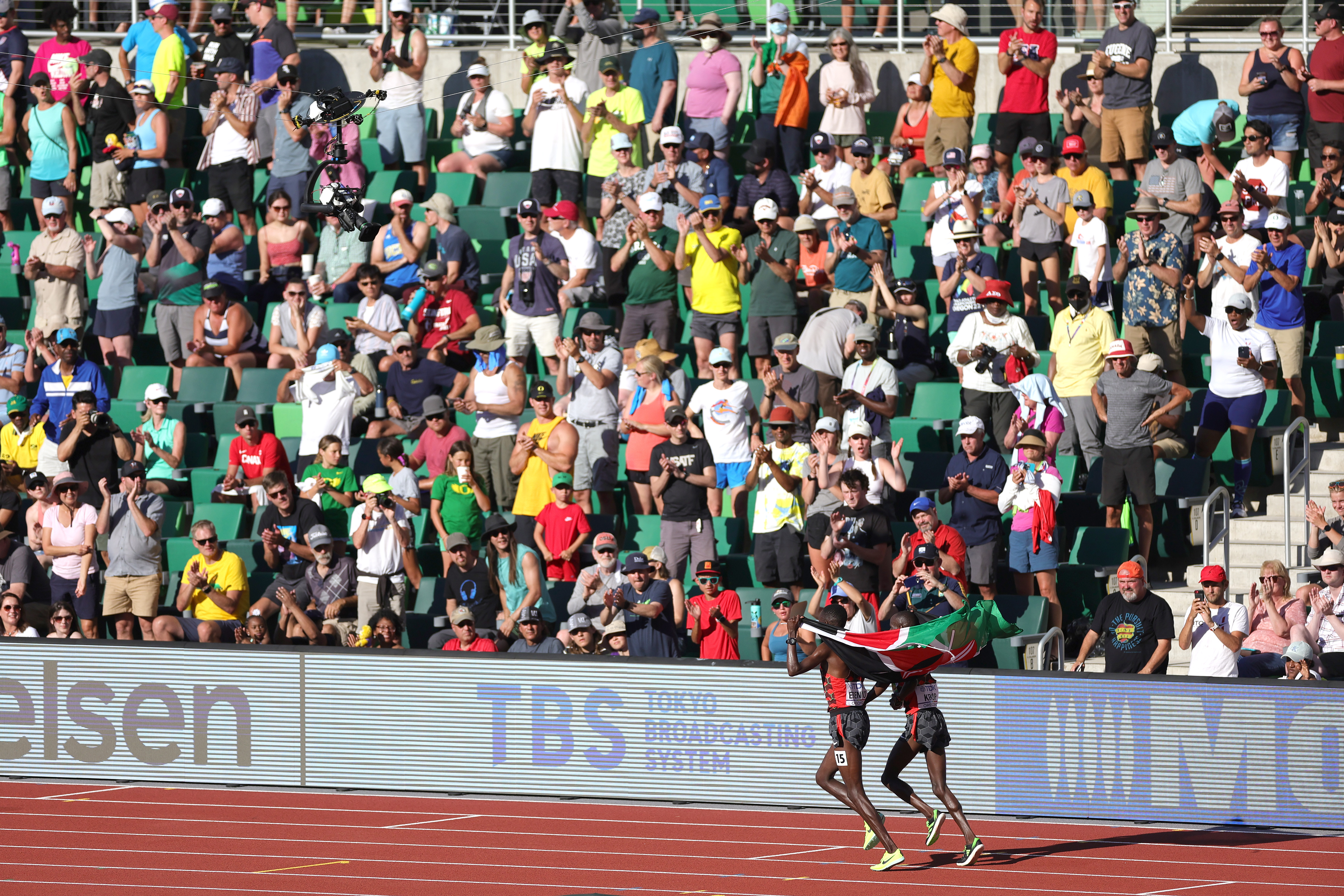For a nation with a relatively small imprint on world sport, Kenya has at least racked up one impressive achievement: 25 of its athletes were suspended or provisionally suspended this year by the Athletics Integrity Unit, many for suspected doping. Small wonder the AIU ranks Kenya as one of seven Category A countries, meaning its athletes must undergo at least three tests in the 10 months prior to a major event in order to compete.
Of course, these Kenyan athletes are far from alone. Earlier this year the former world number one tennis player Simona Halep tested positive for a banned substance at the U.S. Open (she’s arguing it was a result of a contaminated food supplement). And the roster of sportspeople who have been caught doping over recent decades has included some of its best-known stars: Ben Johnson, Tyson Gay, Diego Maradona, Shane Warne, Roy Jones Jr. and, most famously of all, Lance Armstrong. They’re just a smattering of the 3,000 athletes who test positive for banned substances — which build muscle mass, improve oxygen uptake, or increase stamina — every year.
As some might argue, though, so what? It’s become a core question at the heart of sports philosophy (yes, such an academic discipline exists), and it’s a pertinent one, as doping in sport doesn’t look to be going anywhere. So what, exactly, is the nature of one’s objection to doping? Is it the cheating? The risk to the health of people whose very extreme behaviors are inherently risky? The bad example it sets for our children? Our discomfort with the idea of creating cyborg people? Is our enjoyment as spectators being spoiled?
How to Understand the Tour de France (and Actually Enjoy Watching It)
From races within a race and chess-like tactics, our Tour de France 101 will level up your cycling knowledge so that you can actually understand just what the hell is going on
This certainly isn’t a new debate: as classicists know well, ancient Greek athletes consumed bulls’ testicles in the belief that it improved their performance; others ran slathered in olive oil because they thought it added hydration.
Superficially, it may all seem like a legalistic matter — sportspeople not abiding by the rules, however arbitrary these may in effect be. When the improved performance of javelin throwers threatened to start killing spectators, all stadia were not made bigger. Rather, the javelins were changed, arguably to the disadvantage of the discipline’s then-leading athletes. The rules for professional sport, similarly, proscribe technological advances all the time (golf balls that fly too far and too straight, for example).
In 2016, when Maria Sharapova — then a poster girl of women’s tennis — was suspended for her decade-long use of a banned substance, she lost not just millions in sponsorship deals, but also her reputation. Yet until the start of that same year, that substance had not been proscribed at all. A sport’s rules adapt to the sport’s evolution.

But this divisive issue cuts much deeper; otherwise, it would be an easy solution to simply accommodate doping within the rules. Indeed, the debate reframes our perceptions of sports, of what sports are for, and of even what it is to be a human member of society today. Sports, it can seem, apparently require exceptional standards — otherwise we would be just as worked up about the Ritalin-fueled student sitting his exams, or the caffeinated executive, or the amphetamine-pumped soldiers of World War Two. But…we’re not.
“Sports are always going to be challenged to think about what’s at the heart of what they value,” suggests Tom Murray. He’s the former director of the Center for Biomedical Ethics in the School of Medicine at Case Western Reserve University, and the author of Good Sport: Why Our Games Matter — And How Doping Undermines Them.
“Whatever it is that we treasure in sports, in excellence in an athlete or a team, it always seems to come down to talent and a variety of things that those athletes have done to perfect those talents. Not all of those things are regarded as being in the same moral universe. Hard work, training and so on are admired. But doping upends things for being a short-cut. What’s lost is the connection between the things we value most in athletic excellence. At minimum there’s a muddying of that connection, at worst a complete severing.”
There are some compelling counterarguments to this, though. Why, rationally, should any distinction be made between steroids and access to any other form of technological enhancement widely used by elite athletes — from carb-loading to the use of hyperbaric chambers, all of which also bring about a bio-chemical transformation in the body? Why are these generally accepted by governing bodies and spectators alike (though Murray would be happy to outlaw) these too, to be clear) whereas drugs are not?
The Best Women’s Gifts Under $100
And $75…and $50…and $25
Sigmund Loland, professor of sports philosophy at the Norwegian School of Sports Sciences, argues there is a qualitative difference: that the use of an oxygen tent, for example, exploits what he calls the “systemic adaptation” of the athlete’s body (that’s to say, it makes use of what’s already present), whereas a comparable drug, such as erythropoietin, which similarly increases the red blood cell count, overwhelms it. That’s also what makes it potentially dangerous.
What then, about the distinction to be made between doping and access to the very latest in shoes, racquets or bicycles? Loland agrees that’s a problem. “The significant inequalities between athletes and teams in terms of technologies and support systems is of course deeply unfair, and some argue the underprivileged should be given access to drugs to level the playing field there,” he explains. “But that’s not a solution. The solution is to either reduce the ability of [wealthier] athletes to exploit these resources or to distribute access in a fairer way.”
Loland adds that anti-doping regimens are rightly open to a lot of criticisms too: Do they catch enough cheaters? Are the tests good enough? Do the smart people get away with it? “There are costs of many kinds to this testing regime too,” he says, but it’s the lesser evil.”
Not all are convinced by the anti-doping arguments. Professor Andy Miah, chair in science communication and future media at the University of Salford, UK, and author of Genetically Modified Athletes: Biomedical Ethics, Gene Doping and Sport, argues that our perception of drugs in sport has been shaped by sport’s placement within the context of the wider ‘war on drugs’ over recent decades, combined with what he has called “a nostalgia for the amateur ethos of sport”.
“This supposed it was ever just for the sheer enjoyment of play, and that sport and sportspeople have not in fact always evolved — in their fitness, in equipment, in training,” says Miah. “There may have been a time when even training for a sports event was frowned on. But sport is actually a very complex, very serious business now. And the actual project of modern sport is the product of a technological society. [The problem is that] the gut reaction for most everyday people is to maintain the status quo because people have some pre-conceived idea of what’s ‘natural’. It’s either that, or they really have no idea about what elite athletes are already doing within the rules.”
Miah argues that sport is not just an exploration of dedication, competition and talent — and, he stresses, doping is an enhancement to necessary talent, not a substitute for it — but also a glimpse into the future. We should see the use of enhancements as simply leading the way for a similar shift to come in society at large. We are, after all, embracing the idea of everyday enhancement, as rocketing rates of cosmetic treatments and surgery readily attest. Given the advent of CRISPS gene editing technology, we need to gradually come to terms with new forms of enhancement that will change us on a more profound level.

Still, while Tom Murray concedes that sport will never be drug-free (similar to how to many now argue the war on drugs was doomed from the start) he reckons the effort to get close to it is nonetheless worth it. What’s more, his research suggests that the overwhelming number of athletes want their sport to be drug-free; not least, he explains, because the alternative — doping allowed, full transparency — will not solve the problem. In fact, the situation would be, as he puts it, “tyrannical.” There will always be those athletes ready to dope that little bit more.
“Athletes tend to feel trapped [by the free rein argument],” he says. According to Murray, many of these athletes are young people who feel the pressure of pro-doping environments that benefits individuals and institutions (sometimes literal nation-states), which provide, manage and hide the drug-use.
If an athlete refrains from doping, they feel they give up a significant and maybe decisive advantage, after having invested a lot of their identity and excellence into their sport. They can continue to play without doping, leave the sport, or level the playing field again by doping. That’s a nasty set of options. I’d make a plea for a fourth option: the freedom to compete with the reasonable confidence that it’s against those who aren’t doping. But there’s never a certainty — as there isn’t in life, so there isn’t in sport.”
That always leaves room for doubt. Type of sport matters, too. Loland suggests that in contrast to the complex dynamics and learned techniques that determine success in many team sports, “measurement sports” (e.g. track and field events) aren’t sustainable in the long run precisely because they test basic capabilities, like speed. This makes them particularly vulnerable to the “efficiencies” brought on by doping.
But ask whether that doubt changes the way you feel about those athletes who achieve super-human feats in front of you. Ask whether their bid to be “faster, higher, stronger” (as the Olympic motto has it), feels contrary to the spirit of the competition? Does it make you, the spectator, the fan, also feel cheated?
“The bottom line for me is that we want sports to be a measure of talent. Meaning, how have I developed my genetically-given abilities through hard work, through resilience, through taking losses and wins with dignity, under the fair conditions of competition,” says Loland. “That’s an expression of an interesting kind of human excellence that’s worth admiring, which gives sport social value, even as it brings out the best and sometimes the worst in us.
“If you liberalize drugs, you pull the plug on the source of that admiration because drugs over-run the talent,” he adds. “The responsibility for that performance is removed from the athlete and put onto the athlete’s support system. [Take that to its logical conclusion and] ultimately that athlete becomes a constructed and manipulated organism doing a performance. What you’re admiring then is scientific excellence. But it isn’t sporting excellence.”
Whether you’re looking to get into shape, or just get out of a funk, The Charge has got you covered. Sign up for our new wellness newsletter today.


























